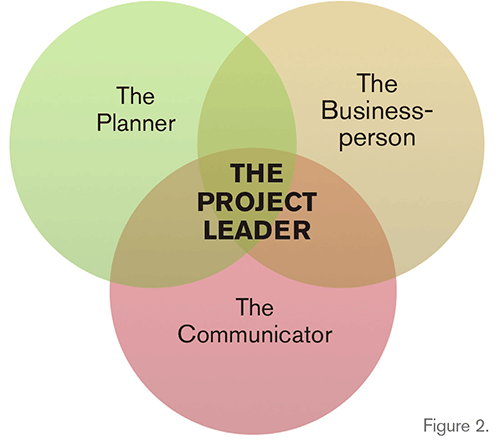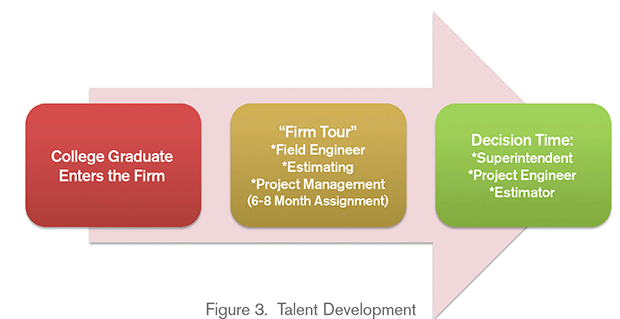A long-standing joke has circulated in the industry that the project manager evolved as the solution to the mounds of paperwork a superintendent encounters. Today, the number of contractors who do not have some semblance of a project management corps is minimal. In fact, project managers drive the operations within many firms, replacing their past image as the replaceable paper pusher. Construction management and engineering programs throughout the world’s universities have developed curricula to educate and train future project leaders on everything from change order management to scheduling. However, what does the future of project management hold? Will the skills of today’s project manager be satisfactory as the complement to the field manager? Will firms have to adapt to a new model of project management as new business models in construction arise?
Examination
Project managers became the custodians of the “business side” of construction projects, enabling the superintendents or foremen to build. While the evolution of the project manager started as an office transition for many blue-collar supervisors, universities became fertile ground for growing future managers. Today, many trade contractors still utilize “star field leaders” as new office managers. The advent of the digital age and the computer skills of many younger managers aided the evolution.
For years, engineering and building construction programs equipped managers with a standard “toolbox” of basic knowledge to enter the world of construction. However, the largest criticism of this management group was their apparent lack of real-world construction knowledge. Many project managers could easily navigate the most sophisticated software but could scarcely find their way around the formwork of a multi-story building. The more sophisticated firms dedicated time and resources to bring the field to these engineers and managers through on-site mentoring by senior field managers, but many firms lacked the depth and sensibilities to develop their managers effectively. More often than not, projects were led by “green horns” with little or no experience, learning through on-the-job training. This has often led to poor office/field relations, poor client management, inadequate change order management and, on many occasions, margin erosion. If not for their strong field supervision, many firms would have experienced more catastrophic failure.
What did the industry learn from this phenomenon? A project may be able to overcome a weak project manager, but it requires strong field leadership to be successful. If nothing else, this trend demonstrated the value of solid front-line leadership. However, in an industry of aging field workers and an already apparent shortage of qualified assets, will there be a population of field managers capable and willing to lead projects in the future?
Evolution
Schools and colleges have begun to stress the importance of balance in their curriculum. Practical training and field experience have bolstered traditional technical subjects such as scheduling and general construction material knowledge. While many of the core technical skills did not change, many managers learned more in the key areas of business management and hands-on constructability. Figure 1 illustrates the evolution that many students experienced in their education.
 Figure 1. Evolution of the Project Management Curriculum
Figure 1. Evolution of the Project Management CurriculumUltimately, educators have determined that the balance must come in the form of project/firm management, hard/soft skill education and technical/business fundamentals. For instance, understanding a job cost report is just as important as understanding the income statement. Simply understanding the strength of a wide flanged steel beam was not enough—managers were expected to understand the safest erection process and how it influenced other trades. Furthermore, construction education began to emphasize the human element—managing people and the customer. Personality profiling systems became as important as strong résumés and reference checks.
Construction firms also evolved in their approach to utilizing the project manager. Best-of-class firms utilized the manager as the customer-focused arm of the business. The greatest project managers were those who could best engage customers, trade contractors, suppliers and tradespeople. The strongest managers were graded less on their technical acumen and more on their prowess with people. In a field predicated on its “hard skills” subject matter, the best managers seemed to be those who understood the “soft skills” of psychology and sociology. In fact, the best project managers, as defined by industry leaders, have been characterized by their ability to simultaneously communicate, plan and think like business people.
- Communicate – The manager has the ability to communicate to any audience and articulate an appropriate message. More important, the true project leader has the ability to listen and process an appropriate response.
- Plan – The manager is diligent about proactively constructing a plan that balances realism and strategy.
- Cultivate Business Acumen – The manager has an affinity not only for making money and understanding the world of finance, but also for managing both internal and external customers.
The intersection of these three skill sets is defined by FMI as the “project leader” (Figure 2). While some managers may be able to effectively plan or communicate, the project leader does these in trinity.
 Figure 2
Figure 2This model is not limited to the sphere of project management. The construction world also saw the emergence of true project leaders in the field. Firms that employed superintendents who took an active role in these three areas dramatically improved their firms’ performance. While these leading superintendents would hardly be mistaken for accountants, they understand earned value, job cost feedback and, most important, their connection to the customer. Today and tomorrow’s superintendents would not be defined only by a limited set of construction skills and knowledge.
The integration of these newly defined roles has presented many firms with an interesting conundrum—providing project managers with more real-world construction experience while teaching superintendents social and business skills. The traditional training practices of most firms are grossly inadequate to support the appropriate level of development required, especially in the face of shrunken training budgets, ailing economies and project teams stressed to simply accomplish project goals. Furthermore, the evolution of these roles is exacerbated by an aging field workforce and a distinct shortage of field leaders capable and willing to lead. It is not uncommon to hear a president or CEO lament about his or her firm’s inability to find good help and, in particular, great field leadership.
Best-of-class firms have recognized this challenge and developed a proactive plan to grow talent rather than engage in “free agent acquisition.” Figure 3 depicts a clear trajectory.
 Figure 3. Talent Development
Figure 3. Talent DevelopmentToo often, firms accelerate the timetable because of short-term personnel needs. But, as simple as this progression appears, the key is firm discipline. Arguably, the greatest benefit to this talent development trajectory is creating a cadre of talent that is versatile. It also allows newer associates to choose—with applicable guidance from senior management—the path that is best suited to their personalities, talents and long-term future. College graduates will often gravitate toward project management because they feel it is the quicker path to the top even when their true desire is to be in the field. Guidance from senior management will help them make the choice that is best for them. Ultimately, this form of career path development addresses future shortages while giving greater opportunities to up-and-coming managers, estimators and superintendents. In the future, superintendents with degrees will be more common than superintendents who were traditional blue- or gray-collared workers. The key to success will lie in the firm’s ability to continue to provide platforms and growth engines for talent development.
Adaptation
As firms wrestle with new paradigms such as integrated project delivery, building information modeling, public/private partnerships and modularization, the role of the project manager will not remain static. Much like professional and collegiate football offenses have redefined the role of the quarterback in the faster and more physical leagues, project managers will adapt.
Firms that employee traditional project managers and field supervision will always exist; however, the best-in-class companies will have a staff of business managers who are adept at directing traffic in the field and who understand the nuances of financial management.
Tomorrow’s firms will have managers and superintendents who work in tandem, but each will need to be more technically savvy and maintain a much higher emotional IQ to better manage the “soft” side of business. Additionally, firms that have some semblance of structured development will cope with the coming scarcity of labor the industry is sure to face. The fittest firms will employ and develop not just managers, but true leaders in the industry.
